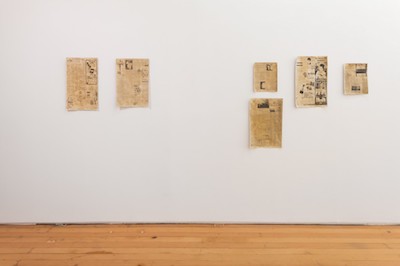Blake Rayne
BLAFFER ART MUSEUM, UNIVERSITY OF HOUSTON
I have seen the work of Blake Rayne in bits and pieces over the years, and in each instance I have been puzzled by what I like to call the ugly ducklings nestled within his installations. By this I mean the one work out of a gaggle of beauties that seems to be deliberately, aggressively out of place. For example, the yogurt container–cum–projection screen perched on the windowsill of Campoli Presti's London gallery back in 2012 (Yogurt Cinema, 2014). In a mostly pristine exhibition, it stood out like a sore thumb.
Sometimes the clash makes sense. The decision to hang paintings next to their wooden transport crates worked marvelously in the 2008 exhibition "Dust of Suns" at Miguel Abreu Gallery in New York, reminding us, once again, that canvases are objects, too. I therefore waited with bated breath for Rayne's midcareer retrospective, curated by Javier Sánchez Martínez, in which the ugly ducklings, with the additional context that only such overviews can provide, would finally become glorious swans.
Or so I thought. Instead of finding peaceful resolution, Rayne's oeuvre seems at war with itself. Take, for example, the atrium-like entry gallery, the first of the show's two rooms, in which Rayne's well-regarded series of canvases that have been folded, sprayed, and sewn (in that order) are understandably highlighted. However, as if to slight their elegance, a gang of incompatible objects—a book of felt (A Line [Almanac], 2013), glasses on a wood table next to a plant in a cardboard box (Table of Contents, 2010), a plastic bottle (Untitled, 2016)—loiters at the center of the room. I suppose the two sets (paintings and things) share a readymade quality. But even so, their visual incongruity overshadows any sense of filiation.
The placement of works in the second room only accentuates the discord. A small squiggly red, white, and blue canvas, Untitled, 2012, neighbors five of Rayne's iconic wall works from the series "Cover Letter," 2010, featuring felt letter a's drooping off their canvases onto the floor. Since I don't think an homage to Brice Marden's "Cold Mountain" paintings or Robert Morris's antiforms is intended, I can only assume that the disjunction between pictorial and sculptural, smooth and textured, line and letter, is the goal here.
Everywhere you turn, unlike is pitted against unlike, most jarringly whenever one's gaze crosses a towering, eclectically composed mobile of T-shirts, 3-D letters, and a bicycle hanging in the middle of the room. One corner of the room does, however, approach legibility: A pair of Day-Glo, dye-sublimation-printed abstract canvases draped with equally garish vinyl garlands, both Untitled, 2010, are a canny criticism of the arbitrary, decorative impulse underlying so much of today's computer-generated painting. Bracketing these is a pile of the aforementioned felt a's, A Line, 2013, and an André Cadere–esque pole. Altogether, the trio surveys the multiple ways in which color can be used as a sign.
Coming from a lesser artist, such cacophony might indicate a confused mind. But works such as Untitled, 2011, a panel onto which a chart from Cynthia and Harrison White's art-historical text Canvases and Careers (1965) has been silk-screened, show that Rayne is no dummy. The graphic lists by year the number of paintings that each of the Impressionists made over the course of their careers, documenting in numeric form their respective moments of breakthrough. Rayne is all too aware of the complicity between the making and the marketing of art. And indeed, interpretations of his work have tended toward over-cerebralization, earnestly shrouding it in a cloud of semio-speak (abetted by Rayne himself, it must be said). While there is something admirable and even necessary about linking such an artistic practice to the digital and the socioeconomic, I fear that this body of work's most striking feature—namely, the violence of its juxtapositions—has been somewhat downplayed in the artist's critical reception.
It is exceedingly ironic that an oeuvre so hostile to any overarching narrative should so often be explained by one. For it is hard to find a practice with a comparable level of purposeful discontinuity and obfuscation. Rayne's work is neither pastiche nor bricolage, neither assemblage nor pure shock. It would seem that the artist seeks above all to preempt totalization of his practice by any interpretive system, going so far as to refuse to establish a system in the first place. The interpreter's frustration would be akin to sexual frustration, were it not for the fact that the work is so decidedly unerotic. Therefore, the closest thing I can come up with is that emblem of mechanized frustration, the bachelor machine, minus Duchamp's irony and duplicity.
—Paul Galvez
View article




















